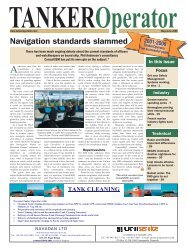Features: - Tanker Operator
Features: - Tanker Operator
Features: - Tanker Operator
Create successful ePaper yourself
Turn your PDF publications into a flip-book with our unique Google optimized e-Paper software.
INDUSTRY - MARKETS<br />
04<br />
Sale & leaseback as a<br />
financial tool in freight &<br />
credit markets - part 1<br />
By Basil M Karatzas*<br />
As anybody in the shipping industry can attest, prices for shipping assets<br />
have been experiencing their highest levels in recent memory.<br />
Asset appreciation has been more<br />
accentuated in the last four years,<br />
as Graph 1 depicts for five-yearold<br />
tankers - VLCCs, Aframaxes<br />
and MRs. The data is provided by the Baltic<br />
Exchange Sale & Purchase Assessment Index<br />
(BSPA) for which Compass Maritime Services<br />
is a panel member.<br />
Although the asset appreciation is welcome<br />
by shipowners who have had the good fortune<br />
and perspicacity to acquire assets in time, there<br />
is always the strategic consideration of how the<br />
shipowner should be utilising the current state<br />
of the markets by unlocking and deploying the<br />
capital appreciation and optimally positioning<br />
the company for the future.<br />
The selective sale of assets (older vintage,<br />
lower quality vessels, etc) is one obvious<br />
answer. However, for tonnage built in the<br />
early 1990's, the consideration is of<br />
maintaining control of the (still modern) assets<br />
in a strong freight market, and keeping access<br />
to tonnage in order to serve strategic accounts<br />
(charterers with their own cargoes) and<br />
generate operating profits.<br />
One such approach of unlocking capital<br />
gains that has been successfully employed by<br />
several shipowners is the sale & leaseback<br />
transaction (SLB), whereas the shipowner<br />
sells a vessel (a tanker for the purposes of this<br />
article) at today's prevailing market rates and<br />
simultaneously taking back the vessel on<br />
employment for a certain period of the time.<br />
In such transactions, the shipowner frees up<br />
capital which can deployed in any way the<br />
owner sees suitable, optimally by placing<br />
orders to renew and replace the fleet, while at<br />
the same time retaining commercial and<br />
operational control of the tanker for a period<br />
of time in a robust freight market.<br />
In order for such a transaction to become<br />
feasible, several parameters are important and<br />
negotiable between the shipowner and the<br />
lessee, terms such as the period (short term<br />
versus long term) and type of employment<br />
(bareboat versus timecharter employment),<br />
purchase options, if any, and of course the<br />
daily rate that the shipowner will be paying to<br />
the new owner and lessor. Several other<br />
parameters indirectly affect the transaction<br />
such as the credit markets and cost of finance<br />
(for leveraged leases), type of asset class and<br />
assessment of residual risk of the vessel at end<br />
of lease, and finally the credit rating of the<br />
shipowner (an ex-owner and charterer of the<br />
vessel once the transaction has been<br />
consummated).<br />
What type of financial concerns would be<br />
interested in acquiring vessels on such terms?<br />
Leasing companies and investment funds that<br />
specialise in leases due to tax reasons (they<br />
can use depreciation for accounting purposes<br />
versus a tax-free shipowner in most cases), for<br />
residual value reasons (in a market moving<br />
higher vessels can have a market value above<br />
book value and thus offer to the financial<br />
owner an attractive return on investment),<br />
fixed income reasons (low risk, low reward<br />
BP Shipcare<br />
The Professional Lay-up Option<br />
Email: bpshipcare@bp.com<br />
Tel: +44 1932 771571 Fax: +44 1932 771690<br />
return) above cost of finance for a credit<br />
worthy lessor.<br />
From a financial and tax point of view in<br />
the US, leases are categorised as either -<br />
a) Capital or finance leases - long-term<br />
leases covering more that 75% of the<br />
vessel's economic life, with the present<br />
value of the lease rental payments<br />
constituting 90% of the vessel's fair<br />
market value, and whereas the lessee<br />
automatically acquires the asset or has the<br />
option to acquire the asset at a bargain price.<br />
b) Operating leases - which are all noncapital<br />
leases (usually short-term leases<br />
where the lessee does not have an interest<br />
in the vessel after the termination of the<br />
lease).<br />
There is also the distinction of 'wet lease'<br />
versus 'dry lease' [in the former, the lessor<br />
provides crewing (timecharter in shipping<br />
terms), in the latter the lessor provides the<br />
vessel alone (bareboat charter)]. A couple<br />
more leasing terms to keep in mind are the<br />
'net lease' where all costs associated with<br />
insurance, taxes, maintenance are paid by the<br />
lessee/charterer, and the 'leveraged lease'<br />
where the lessor arranges financing through a<br />
long-term creditor.<br />
Commercial applications<br />
Having covered the basic terminology, it's<br />
time to turn to the commercial applications of<br />
leasing in shipping.<br />
When negotiating the terms of a sale &<br />
Your answer to<br />
a low freightrate<br />
environment and<br />
standdown<br />
periods<br />
Website: www.bpshipcare.com<br />
Tel: +60 87 415277 Fax: +60 87 415330<br />
clean seas safe ships commercial success<br />
TANKER<strong>Operator</strong> � August/September 2008

















